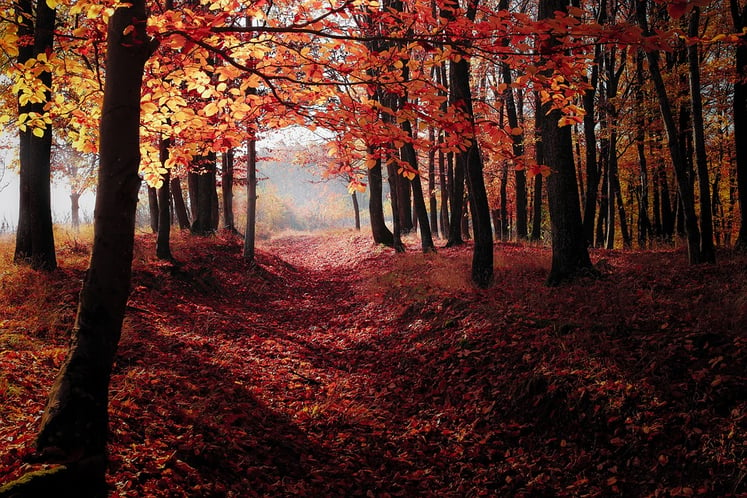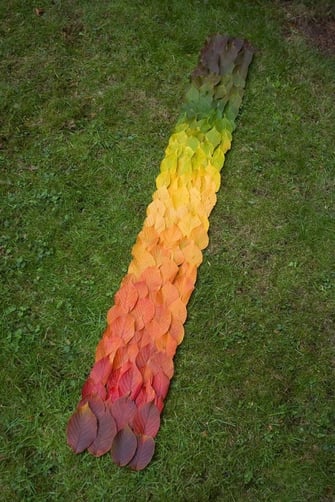Weather’s Influence on Fall Foliage
by Daphne Thompson, on Oct 4, 2016 10:46:05 AM
Weather’s influence on fall foliage is critical. From storm devastation to frigid temperatures, the quality of the visuals that make autumn the favorite season of many hinges upon it. What causes the reds, pinks, magentas, oranges, yellows, purples and combinations of the pigments seen most every year?
Leaves like colorful confetti sweep across southeast Michigan! Fall sure is a party in #PureMichigan. 🎉
— Pure Michigan (@PureMichigan) October 28, 2018
📸: Instagram fan @eolsen813 in Romulus #FallFilter #VisitDetroit @VisitDetroit pic.twitter.com/yszGrd1HGI
Deciduous Foliage
Colorful autumn foliage falls because deciduous plants enter abscission, wherein they lose all of their leaves. Such behavior is not seen in semi-deciduous plants, which don’t shed their leaves until new growth begins. The retention of dead leaves is called marcescence. Although dry and brittle, the petiole - the stalk that attaches leaves to their stems - remains alive.
What’s the harm in deciduous trees keeping their leaves healthy throughout winter? The harsh season requires either protecting leaves like evergreens or allowing them to separate and start anew in the spring. Protecting a pine needle requires far fewer resources than, for instance, a maple leaf. Fallen leaves reduce overall water loss, help defend from the cold, the snow, the ice and the typically strong, drying winds that come with them. The ravages of winter make the most effective strategy for survival to stop the collection of radiation by killing off and dropping foliage and then hibernating before attempting to bud the following growing season again.

The Formation of Fall Colors
Longer nights and cooler temperatures signal for the introduction of a layer of cork cells at the base of each leaf, which cuts off their access to water and minerals by gradually sealing off the veins. Prebuilt, protective scars are left on the tree once a leaf reaches maturation and falls naturally.
Vibrant greens exist because of chlorophyll: a biomolecule that resides inside cellular organelles called chloroplasts and captures solar radiation for use in altering existing chemicals in a plant. Blue wavelengths are gathered most, followed by reds. A process called charge separation transfers the energy of a gathered photon into an electron. An oxidation reaction removes the electron from the chlorophyll, and it is then transferred to molecular intermediates called the electron transport chain for use throughout the plant. Capturing solar energies naturally depletes chlorophyll, but plants highly prioritize both building more and placing it in the leaves to most effectively steal sunrays where they stand. Plants that have received insufficient sunlight, such as after a sky darkening volcanic explosion, have less and appear pale.
Driving through colorful broccoli. #vermont #Foliage #fallfoliage #dji #mavic2pro #aerialphotography pic.twitter.com/CQZQRw74TG
— Manish Mamtani (@ManishMamtani) October 16, 2018
Green pigments are reduced when much corking has already occurred and much of the chlorophyll has degraded into nonfluorescent chlorophyll catabolites. Autumnal chlorophyll degradation is now thought to be catalyzed by chlorophyll b reductase. It reduces chlorophyll b to 7-hydroxymethyl chlorophyll a, which then reduces to chlorophyll a. Chlorophyll a destabilizes existent apoproteins: some of chlorophyll’s vital enzymes. As chlorophylls degrade, chunks, some in the forms of amino acids, are separated, sorted and stored in the roots, trunk, branches and stems for the easy reproduction of leaves the following growing season.

When the rate of chlorophyll replacement becomes much slower than the speed of disassembly, carotenoids - housed in organelles called plastids - become the most prominent pigments, including the yellows from xanthophylls, the oranges from beta-carotene, some brownish tones and everything in-between. Carotenoids dominantly color 15-30% of tree species in the fall. Unique abundance in plants leads to yellowish tints even throughout the summer.
Later in the cycle of decay, when about half of the chlorophyll has been depleted, new compounds called anthocyanins are produced in the abundance of the disassociated amino acids, yielding vivid combinations of red, scarlet, crimson, purple, and even blue or black if influenced by certain pH levels. Bright light and a reduction of phosphates are required to break down the sugars trapped within a leaf’s cells’ sap, which are then used when producing pigments. New England is unique for its abundance of anthocyanins, produced by around 70% of its trees.
Evidence suggests that the biomolecules warn parasitic insects to stay away. Some see red leaves on a tree and instinctively assume it’s a producer of chemical defenses. The fact that anthocyanins modify how sugars are broken down in leaves propels another theory: that the water-soluble chemicals are present because they allow for more efficient absorption of nutrients when water and mineral flows are suppressed by cork cells.
Deep oranges, pinks, magentas, fiery reds, and bronzes are mixes of abundant carotenoids and anthocyanins. Tannins produce brown or tan tints, typically expressed as spots often misidentified as disease. Other reasons for brownish coloration are dehydration and death. Brown is the color of the leaf’s cellular walls after drying has faded all of the coloring pigments. Leaves that fall within the reaches of the roots are naturally composted and recycled by soil degradation and osmotic transference back into the roots.
Weather’s Influence on Fall Foliage
Several factors affect fall colors. Soil moisture differentiation and weather’s influence on fall foliage make no autumn identical. Temperatures and timings of precipitation matter for the efficacy of the many chemical reactions that lead to stunning viewing. Foliage on tall mountains, for instance, changes first because of the temperature variation.
Another factor is nutritive and non-toxic atmospheric composition. Global climate change may be great news for trees because it would extend their growing season and liberate higher levels of carbon dioxide, which enhances photosynthesis, alters arboreal biochemistry and delays the onset of fall.
Fall is here, which means cooler temperatures & leaves turning into beautiful #fall colors! Check out @forestservice's Fall Colors 2018 webpage to find info about where & when to see fall colors in your part of the country 🍂🍂 https://t.co/KjFsNY44f5 pic.twitter.com/M3CkJvDkYY
— Dept. of Agriculture (@USDA) September 27, 2018
The biological processes of plants vary significantly from season to season due to variations in the weather. Over-watering or flooding starves a plant of oxygen, which can inhibit color development. Droughts also inhibit the chemical reactions. Late spring, severe summer, and warm autumn droughts can delay displays by a few weeks. Wintry conditions onsetting early stunt the processes involved in generating fall colors, often making for dismal viewing. Devastation from swift winds can diminish or end viewing seasons, especially after sufficient corking has already occurred and the leaves are loosely stuck to the trees.
The most colorful autumns are created with an abundance of bright sunlight, used when synthesizing pigments. Warm, rainy springs and ideal summer weather prepare chemicals in deciduous plants for effective biomechanisms during the onset of abscission. Daytime temperatures warm enough to keep nighttime lows above freezing and clear days and nights that permit both optimal sunshine and crisp dawns are ideal autumnal conditions for enhancing the reactions that lead to beautiful falls.
Autumn has begun! 🍂 What an ace season. Crispy, colourful, chilly, charismatic.. 🍁#AutumnColours #FallColors #AutumnLeaves #FallLeaves #FallSeason #Autumn🍂 #FirstDayOfAutumn pic.twitter.com/IbyFYl7ufq
— Michael Perry -Mr Plant Geek™ (@mr_plantgeek) September 23, 2018
The best displays of deciduous dissemination worldwide are southern mainland Canada, the eastern US, the Rocky mountains, Argentina, New Zealand, some of East Asia, Russia, the Caucasus mountains, and northern and western Europe north of the Alps. North America has almost sixteen times Western Europe’s variety of tree species, making for greater color depth. Most of the credit goes to our longitudinally-oriented mountain ranges, which preserved species during the successive arboreal eradications forced by glaciers during the ice ages.
Wondering where to check out fall color and when the peak is expected? Check out this site produced by the Smoky Mountains National Park.
UPDATED: October 30, 2018







